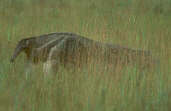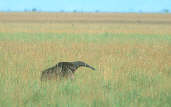
July 2001
The Giant Anteater is found in a wide variety of habitats from wet and dry grassland to forest providing there are ants or termites available for food. It ranges from Belize to Paraguay and northern Argentina.

Their prey is extracted using its very long, sticky tongue but it only eats a few ants from each colony mainly because the soldier caste of ants or termites arrive to defend the colony and see off the anteater with bites or noxious chemicals.
Anteaters give birth to a single young which travels by clinging to the fur on the back of the mother. Because the mother has neither teeth nor fingers, the youngster has to crawl onto its mother's back by itself.
There are illustrations in Eisenberg & Redford, Page 92; and in Emmons, Plate 4.
| Previous Page | Back to Index | Next Page |